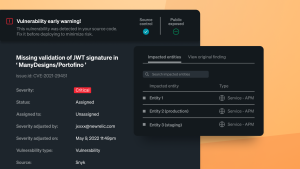For decades, software has been disrupting industries from agriculture to entertainment to healthcare. At this point, most top executives I speak with understand that delivering great software-based experiences to customers is essential to business success.
They also understand why it’s important: By 2020, customer experience will surpass price and product as the key brand differentiator for companies, according to Walker Information, a market research firm.
Far fewer executives, however, appreciate just how much business value is locked up in how they deliver that software. Companies that make the technological, cultural, and organizational changes to modernize their software infrastructure can capture constant, real-time, highly actionable insights on the performance of their businesses. Has a slowdown in the responsiveness of a webpage caused would-be customers to wander off to a competitor’s site? Does changing a “buy now” button from red to blue cause sales to increase in Topeka? What about in Taipei? How quickly do customers go to pick up their purchase at a local retail location after buying something during a flash sale? Does a surge of consumer requests for a new kind of service indicate a major new business opportunity?
The age of observability
Such dollar-and-cents insights are the latest frontier made possible by software monitoring. For many years, your company’s developers and IT ops people have used monitoring tools to identify and diagnose performance problems (such as website outages and slow-running applications) by analyzing metrics, events, logs, and traces—known as M.E.L.T. in industry parlance. These tools provide what techies call “observability,” and do it far more reliably and efficiently than humans watching big screens in network operating centers.
But today, monitoring in this purely IT context should be a standard best practice. Given how crucial digital technology is to all aspects of business, leading companies want a higher-level “observability platform” that allows them to “instrument” almost anything that may have business value—say, what does changing that red buy button to blue do to order volumes? A true observability platform must be open, connected, and programmable.
No more operating in the dark
These benefits are not hypothetical. Forward-leaning companies such as Capital One, Fox, and Nationwide now routinely mine software performance data to achieve ambitious business results. Executives at companies like these often tell me they feel as though they’ve been given the gift of sight, whereas before they had been operating in the dark.
Over the years, companies have tried other ways to leverage technology to get such insights, such as big data analytics. This process typically involved assigning an MBA analyst to do an expensive, bespoke investigation on a given issue. A few weeks later, interested parties would receive a report, usually too late to have any real-world impact. Even if the information was still actionable, it could take weeks or months to figure out how to implement any changes.
By building observability into the software-delivery infrastructure, data is captured as a matter of course. Properly implemented, such systems let people visualize data patterns in a context that makes sense to them and allows them to take immediate action. Say the monthly bill for public cloud services suddenly spikes by $50,000. Rather than launch an investigation, the IT Ops team would be able to easily see that the increase coincided with the rollout of a new video-related service, and they’d also have access to real-time information on consumers’ usage of the offering. Armed with this information, management could decide whether to simply turn the feature off, assign engineering resources to work with the cloud provider to make the service run more efficiently, or accept the $50,000 as a reasonable investment for a promising new business.
Harnessing the true power of observability to grow your business involves more than just having the right technology solution in place, however; it also requires making these four fundamental changes to how your business operates:
1. Break down your IT silos
To be able to respond quickly to software performance data, your software development teams need to work in close coordination with the IT operations teams responsible for delivering their applications to customers. That’s what technology management practices such as Agile development and DevOps are all about. Make it a priority to educate yourself on these software development methodologies.
2. Make your IT organization’s KPIs less IT-centric
Historically, IT departments have focused on achieving goals they could control, such as hitting uptime targets or shifting applications to the public cloud. Given the importance of software today, that’s no longer good enough. There’s no scenario in which it’s okay for an application to be “technically” available but for some reason inaccessible to the customer.
As a result, leading IT shops are replacing traditional metrics and KPIs (key performance indicators) with ones that measure real-world impact on customers and on the health of the business. Why measure your success on the “mean time between failure” (MTBF) of particular apps or on how well the team did at hitting development milestones, which have no impact on the actual experience people have with your service? True observability means being able to measure IT’s actual impact on customer engagement: the number of first-time customers and other metrics that your CEO, CFO, and CMO care about. That way, if performance data shows customers are having an awful experience with that new app, IT leadership won’t be inclined to pass the buck just because the MTBF stats look fine. They’ll have every incentive to begin working on a fix in 10 minutes, not 10 days.
Given the vast range of software performance data that can be mined, these KPIs can be very specific. If you’re looking to increase engagement in an online auction for a particular product, set a KPI around the ratio between the number of times a person views the product page and makes a bid. Or design KPIs to help learn more about the key drivers of your business. What would the impact on the profitability of a business be if the team could lower website-related customer service calls by 30%?
3. See the big picture
In today’s multi-channel world, it’s crucial to maintain the customer experience across all of your digital touchpoints. That means having visibility into everything that impacts that overall customer experience: your browser and mobile apps, your infrastructure and the public cloud providers you partner with, and every step of your customer’s digital experience.
Unfortunately, many companies still rely on dozens of unconnected point-solution tools to monitor these various sub-categories, each of which only captures data in a way that’s meaningful to a specific type of user, such as a developer or a network engineer—such fragmentation fails to yield high-level insights.
This is why savvy companies are investing the resources into building more integrated, flexible observability systems. At companies like USA Today Network, I’ve seen everyone from rank-and-file programmers to business unit managers have access to a dashboard where they can view page load times, SEO data, advertising performance, and other important information.
4. Embrace the OKR trend
Rather than make business decisions based on the best hunches of top executives, the Objectives and Key Results (OKRs) approach relies on more frequent analysis of what’s possible by those teams that are closest to customers, and therefore best positioned to understand how to turn opportunities into measurable results. More and more fast-growing companies are adopting this bottoms-up way of achieving ambitious business goals (I recommend all business leaders read John Doer’s Measure What Matters). Done right, OKRs can help teams and companies drive accountability and thrive.
Digital native companies such as Google were born ready to adopt this approach, since their business was always based on data. Today, I’m seeing many companies trying to adopt OKRs, and they’re partnering with New Relic to help build the required data underpinnings.
Even as delivering software is becoming more and more complex, it’s become ever more crucial to running a successful modern business. Chances are neither of these trends are likely to slow or reverse. If you’re a CEO, CTO, or other business leader who understands that every business is a software business, you owe it yourself to make sure you’re listening to what your software is saying, and taking action to improve the business. You can guarantee your competitors are.
The views expressed on this blog are those of the author and do not necessarily reflect the views of New Relic. Any solutions offered by the author are environment-specific and not part of the commercial solutions or support offered by New Relic. Please join us exclusively at the Explorers Hub (discuss.newrelic.com) for questions and support related to this blog post. This blog may contain links to content on third-party sites. By providing such links, New Relic does not adopt, guarantee, approve or endorse the information, views or products available on such sites.



